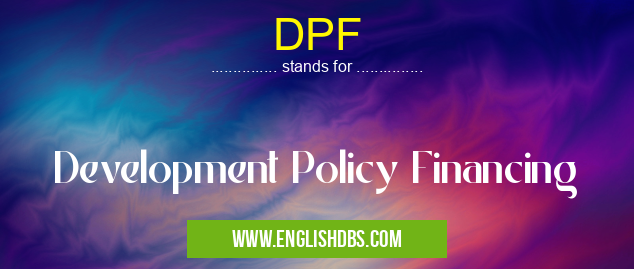What does DPF mean in DEVELOPMENT
DPF aims to:

DPF meaning in Development in Community
DPF mostly used in an acronym Development in Category Community that means Development Policy Financing
Shorthand: DPF,
Full Form: Development Policy Financing
For more information of "Development Policy Financing", see the section below.
» Community » Development
Purpose of DPF
- Support macroeconomic stability and structural reforms.
- Promote sustainable and inclusive growth.
- Address social and environmental challenges.
- Enhance resilience to economic shocks.
Features of DPF
- Concessional loans or grants: DPF is typically provided at below-market interest rates or as grants.
- Program-based: DPF is linked to specific policy reforms and development objectives.
- Technical assistance: DPF often includes technical assistance to support capacity building and implementation.
- Conditionality: DPF may be subject to performance criteria and policy commitments.
Benefits of DPF
- Supports economic growth: DPF can provide resources for infrastructure, education, health, and other sectors that drive economic development.
- Promotes stability: DPF can help stabilize economies by providing financial support during periods of crisis or transition.
- Encourages policy reforms: DPF can incentivize governments to implement sound economic policies and reforms.
- Fosters collaboration: DPF often involves collaboration between multiple international financial institutions and recipient countries.
Essential Questions and Answers on Development Policy Financing in "COMMUNITY»DEVELOPMENT"
What is Development Policy Financing (DPF)?
DPF is financial assistance provided by international financial institutions (IFIs) to support a country's economic and social development policies. It is designed to promote economic growth, reduce poverty, and improve living standards.
How does DPF work?
DPF is typically provided as a loan or grant that is tied to the implementation of specific policy reforms. The reforms are negotiated between the IFI and the borrowing country and are aimed at addressing key economic and social challenges.
What are the benefits of DPF?
DPF can provide several benefits, including:
- Supporting the implementation of sound economic and social policies
- Promoting economic growth and poverty reduction
- Improving access to essential services such as health and education
- Strengthening governance and institutions
What are the eligibility criteria for DPF?
Eligibility for DPF typically depends on a country's economic performance, commitment to reform, and compliance with international standards. IFIs assess a country's macroeconomic stability, fiscal discipline, and progress towards achieving its development goals.
What are the repayment terms for DPF?
Repayment terms for DPF vary depending on the IFI and the specific loan agreement. Generally, DPF loans have concessional interest rates and longer repayment periods than commercial loans.
Final Words: DPF is a valuable tool for supporting the economic and social development of developing countries. By providing financial assistance, technical expertise, and policy guidance, DPF helps countries address their challenges, promote sustainable growth, and improve the well-being of their citizens.
DPF also stands for: |
|
| All stands for DPF |
